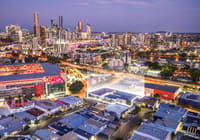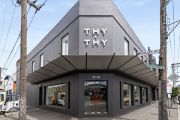
Small tenants quick to snap up space in 333 George Street
Strict constraints on Charter Hall’s 333 George Street site have given the Sydney CBD a new building with smaller floor plates that suits the growing market for small tenancies.
But it came about more by circumstance than intent. Conceived in the cautious aftermath of the global financial crisis, the site the developer had acquired at the bottom of Sydney’s historic Martin Place faced a number of challenges.
Tough planning rules to reduce overshadowing on Martin Place across the road to the south-east curbed the height of the building and the small corner site at Regimental Square meant designing the new building was going to be a challenge, says Grimshaw Architects partner Andrew Cortese.
“The building, because of its location on Martin Place, was very much constrained by the solar plane,” Cortese says. “The overall site area was around 1100 square metres and they wanted 1000-square-metre floorplates.”
The $250 million speculative build was a challenge in a market where larger floor plates were growing in popularity. But the building with a net lettable area of 14,500 square metres is now fully let. Sydney’s beating commercial heart, once dominated by large financial services companies, is increasingly making way for the new employers of choice – technology and start-up businesses – and the building is riding on that wave. In January, global co-working giant WeWork took 4,300 square metres over five floors of the curved tower that steps back distinctively from the street at its higher levels and gives their occupants private terraces.
But it was a tough task. None of three firms pitching for the job in the design competition could make it meet Charter Hall’s commercial requirements and also reach the City of Sydney’s design standard required for a building in that part of the city.
It took a second round of re-worked submissions to get a plan that worked.
“We had to squeeze in as many floors within the solar envelope as possible – which meant smaller floors at high levels of efficiency, a building which had to acknowledge its circumstance in Martin Place and George Street and generally it was considered that 1000-square-metre footprints was the minimum size that was viable in the market when everyone was pursing 1500 square metres and larger,” Cortese says.
They went for a side core on the western face of the site alongside Wynyard Lane, freeing up 92 per cent of the floor plates for use. Floor-to-floor heights were kept a low 3.6 metres. And by using only six columns – along with the core shaft – to hold up the building, they were able to cantilever the floor plate out five metres so the facade lined up nearly with the perimeter of the site and maximised the floor area.
“We built it with cantilevered edges, which overlook Regiment Square and George Street,” Cortese says. “That’s how we got the floor plates to work. On that basis, the building became viable.”
The building constructed by Watpac, which suffered a hit in its own earnings last year due to a 36-hour flood on the site last January that delayed the project, has a 2000 square metres in retail tenancies occupied by Woolworths, NAB and HSBC.
The 16th floor at the top of the building has been leased by a Chinese investor.
“The building’s design approach to form, detail and heritage has been carefully considered to suit the significant location and harmoniously integrates into the established precinct of Martin Place,” Charter Hall group executive for office Adrian Taylor says.
The flexibility of the floorplate and ability to take in smaller tenants meets the city’s growing need for smaller tenancies, says Cortese, whose own firm leases a floor of the building.
“The bigger floorplates have tended to go to the periphery of the city,” he says. “There are going to be more opportunities for consolidation of parts of the middle of the city. A lot of B-grade or older A-grade buildings, as they are refurbished or remade, suit this new emerging tenant profile. We’ve got 100 people in 900 square metres. You can get really nice working communities at that scale.”













